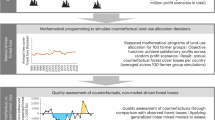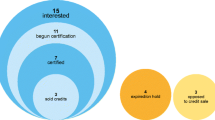Abstract
In this article the authors contend that the constraints to including reduced emissions from avoided tropical forest deforestation and degradation in international carbon markets stem from problems associated with: (1) correctly measuring emissions savings from avoided tropical forest deforestation and degradation; (2) the permanence and ‘leakage’ of tropical forest conservation regimes; (3) ensuring economic incentives for the avoidance of tropical forest deforestation and degradation are sufficiently effective; (4) the exclusion of reduced emissions from avoided tropical forest deforestation and degradation from critical international climate change policy agreements; and (5) the behaviour of investors in carbon markets. Case analysis of the ‘Emissions Biodiversity Exchange Project for the 21st Century’ (EBEX21) program of Landcare Research New Zealand is used to examine how a government-supported market-based forest conservation initiative can be used to address these constraints, particularly in the context of small-scale forestry conservation.
Similar content being viewed by others
Notes
Decision 11 of COP7, paragraph A1, defines a forest as ‘a minimum area of land of 0.05–1.0 hectares with tree crown cover (or equivalent stocking level) of more than 10–30 per cent with trees with the potential to reach a minimum height of 2–5 m at maturity in situ···’. This forest definition is often called the Kyoto Forest Definition. It also defines deforestation as ‘the direct human-induced conversion of forested land to non-forested land’. Paragraph E16 requires each Annex 1 country to select the minimum tree cover area and height applicable to that country and justify that selection. Decision 19 of COP9 has a similar requirement in relation to countries within which CDM projects are located. Up to COP 15, there has been no decision on the forest and deforestation definitions to be applied for REDD+ implementation.
In relation to climate change mitigation efforts from forests in the Kyoto Protocol, IPCC (2003) defined forest degradation as ‘A direct human-induced long-term loss (persisting for X years or more) of at least Y% of forest carbon stocks[and forest values] since time T and not qualifying as deforestation or an elected activity under Article 3.4 of the Kyoto Protocol···’ IPCC acknowledged that there is no solid definition for Kyoto forest degradation as current available definitions cannot accommodate criteria required.
The New South Wales Greenhouse Gas Abatement Scheme recognizes offset credits from avoided deforestation, although this is limited to avoided deforestation projects located in New South Wales (Bayon et al. 2007).
1 USD = 1.7NZD (as at 18th May 2009).
References
Amalric F (2006) Pension funds, corporate responsibility and sustainability. Ecol Econ 59(4):440–450
Angelsen A (2008a) REDD models and baselines. Int For Rev 10(3):465–475
Angelsen A (ed) (2008b) Moving ahead with REDD: issues, options and implications. CIFOR. Bogor, Indonesia
Aukland L, Costa PM, Brown S (2003) A conceptual framework and its application for addressing leakage on avoided deforestation projects. Clim Policy 3(2):123–136
Aune J, Alemu A, Gautam K (2005) Carbon sequestration in rural communities: is it worth the effort? J Sustain For 21(1):69–79
Bayon R, Hawn A, Hamilton K (2007) Voluntary carbon markets: an international business guide to What They Are and How They Work. Earthscan, London, Sterling
Benn S, Dunphy D, Griffiths A (2006) Enabling change for corporate sustainability: an integrated perspective. Aust J Environ Manage 13(3):156–165
Beveridge R, Guy S (2005) The rise of the eco-preneur and the messy World of environmental innovation. Local Environ 10(6):665–676
Brown S, Burnham M, Delaney M, Powell M, Vaca R, Moreno A (2000) Issues and challenges for forest-based carbon-offset projects: a case study of the Noel Kempff Climate Action Project in Bolivia. Mitigation Adapt Strategies Glob Change 5:99–121
Burrows W (2002) Seeing the woodland for the trees- An individual perspective of Queensland woodland studies. Trop Grassl 36(2):202–217
Butler R (2008a) Papua signs REDD carbon deal to generate income from rainforest protection www.mongabay.com. Reported on http://news.mongabay.com/2008/0514-papua.html. Accessed 13 January 2009
Butler R (2008b) Private Equity firm buys rights to ecosystem services of Guyana rainforest. www.canopycapital.co.uk and www.mongabay.com. Accessed 13 January 2009
Cacho OJ, Lipper L (2007) Abatement and transaction costs of carbon-sink projects involving smallholders. Agriculture and Economic Development Analysis Division, The Food and Agriculture Organization of the United Nations (FAO). ESA Working Paper, 06-13, Rome. http://www.fao.org/es/esa/en/pubs_wp06.htm. 10th September 2010
Cacho O, Marshall G, Milne M (2005) Transaction and abatement costs of carbon-sink projects in developing countries. Environ Dev Econ 10(5):1–18
Capoor K, Ambrosi P (2008) State and trends of the carbon market 2008. World Bank, Washington
Carswell F (2006) Could biodiversity add value to New Zealand’s Kyoto forest credits. N Z J For 1(1):31–33
Carswell F, Frame B, Matin V, Turney I (2003) Exchanging emissions for biodiversity: in pursuit of an integrated solution in New Zealand. Ecol Manag Restor 4:85–93
Coomes O, Grimard F, Potvin C, Sima P (2008) The fate of the tropical forest: carbon or cattle? Ecol Econ 65(3):207–212
Dargusch P, Griffiths A (2006) Introducing a typology of environmental markets. Aust J Environ Manage 15(2):70–76
DeFries R, Achard S, Brown M, Herold D, Murdiyarso B, Schlamadinger B, de Souza C Jr (2007) Earth observations for estimating greenhouse gas emissions from deforestation in developing countries. Environ Sci Policy 10(4):385–394
Dutschke M, Pistorius T (2008) Will the future be REDD? Consistent carbon accounting for land use. Int For Rev 10(3):476–485
EBEX21 (2004) A national system for greenhouse has measurement, management, and mitigation, EBEX21, Issue 4, May 2004
EBEX21 (2006) Landowner eligibility for selling carbon credits. Landcare Research, New Zealand, available at URL: http://www.ebex21.co.nz/carbon_credits_sell.asp. Accessed 12 August 2007
EBEX21 (2007) Newsletter on carbon credits from native forest regeneration. EBEX21, Issue 11, January 2007, Wellington, New Zealand
EBEX21 (2008) Frequently Asked Questions. Landcare Research, New Zealand, available at URL: http://www.ebex21.co.nz/carbon_credits_sell.asp. Accessed 19 May 2008
Essama-Nssah B, Gockowski JJ (2000) Forest sector development in a difficult political economy: an evaluation of Cameroon’s forest development and World bank assistance (preliminary report). Operations Evaluation Department World Bank, Washington
Eyles G (1985) The New Zealand land resource inventory erosion classification’, water and soil miscellaneous publication 85, water and soil directorate. Ministry of Works and Development, Wellington, New Zealand
FAO (2006a) Global Forest Resources Assessment 2005, Progress towards sustainable forest management. United Nations Food and Agriculture Organization. Rome, Accessable at http://www.fao.org/docrep/008/a0400e/a0400e00.htm. Accessed 13 January 2009
FAO (2006b) Submission by the Food and Agriculture Organization of the United Nations: Reducing Emissions from Deforestation in Developing Countries. In UNFCCC Workshop on Reducing Emissions from Deforestation in Developing Countries. Rome: UNFCCC
FAO (2007) Reducing Emissions from Deforestation in Developing Countries: Recent Developments in UNFCCC. In: Advisory Committee on Paper and Wood Products.: Food and Agriculture Organization, United Nations, Shanghai
FAO (2008) Forests and Climate Change. In: African Forestry and Wildlife Commission Sixteenth Session and the Near East Forestry Commission Eighteenth Session.: Food and Agriculture Organization, United Nations, Khartoum, Republic of the Sudan
Gullison R, Frumhoff J, Canadell C, Field D, Nepstad K, Hayhoe R, Avissar L, Curran P, Friedlingstein C, Jones D, Nobre C (2007) Environment: tropical forests and climate policy. Science 316(5827):985–986
Gunningham N, Thornton D, Kagan R (2005) Motivating management—corporate compliance in environmental protection. Law Policy 27(2):289–316
Houghton R (2007) Balancing the global carbon budget. Annu Rev Earth Planet Sci 35(1):313–347
Humphreys D (2008) The politics of ‘avoided deforestation’: historical context and contemporary issues. Int For Rev 10(3):433–443
IPCC (2003) Good practice guidance for land use, land-use change and forestry. Institute for Global Environmental Strategies, Kanagawa, Japan
IPCC (2007) Climate Change 2007: The Physical Science Basis. Contribution of Working Group I to the Fourth Assessment Report of the Intergovernmental Panel on Climate Change. [S Solomon, D Qin, M Manning, Z Chen, M Marquis, KB Averyt, M Tignor and HL Miller]. Cambridge University Press. Cambridge, United Kingdom and New York, NY, USA
Karsenty A (2008) The architecture of proposed REDD schemes after Bali: facing critical choices. Int For Rev 10(3):433–458
MAF (Ministry Of Agriculture and Forestry) (2006) Permanent Forest Sink Initiative: A guide to eligible land’, Ministry of Agriculture and Forestry’, New Zealand, available at URL: www.maf.govt.nz/forestry/pfsi. Accessed 8 August 2007
Marland G, Fruit K, Sedjo R (2001) Accounting for sequestered carbon: the question of permanence. Environ Sci Policy 4(6):259–268
Murray B, McCarl B, Lee H (2004) Estimating leakage from forest carbon sequestration programs. Land Econ 80(1):109–124
Osborne T, Kiker C (2005) Carbon offsets as an economic alternative to large-scale logging: a case study in Guyana. Ecol Econ 52(4):481–496
Persson U, Azar C (2007) Tropical deforestation in a future international climate policy regime—lessons from the Brazilian Amazon. Mitigation Adapt Strategies Glob Change 12(7):1277–1304
Smith G (2005) Green citizenship and the social economy. Environ Politics 14(2):273–289
Terry S (2007) Heat treatment, New Zealand Listner, 208, 1, available at URL: http://www.listener.co.nz/issue/3489/features/8462/heat_treatment. Accessed 15 August 2007
Totten M, Pandya S, Janson-Smith T (2003) Biodiversity, climate, and the Kyoto protocol: risks and opportunities. Front Ecol Environ 1(5):262–270
Trotter C, Tate K, Scott N, Townsend J, Wilde H, Lambie S, Marden M, Pinkney T (2005) Afforestation/reforestation of New Zealand marginal pasture lands by indigenous shrublands: the potential for Kyoto forest sinks’. Ann For Sci 62(8):865–871
UNFCCC website (2010) CDM Statistics. http://cdm.unfccc.int/Statistics/index.html. Accessed 10th September 2010
van Kooten C, Sohngen B (2007) Economics of forest ecosystem carbon sinks: a review. In Resource Economics and Policy Analysis (REPA) research group. Department of economics. University of Victoria, Victoria, Canada
Weerawardena J, Sullivan Mort G (2006) Investigating social entrepreneurship: a multidimensional model. J World Bus 41(1):21–25
World Bank (2004) Biocarbon fund. Carbon Finance at the World Bank, Washington DC
Zwick S (2008) Painting the Town REDD: Merrill Lynch Inks Massive Voluntary Forest Deal. www.ecosystemmarketplace.com. Reported on http://ecosystemmarketplace.com/pages/article.news.php?component_id=5584&component_version_id=8076&language_id=12. Accessed 13 January 2009
Author information
Authors and Affiliations
Corresponding author
Rights and permissions
About this article
Cite this article
Dargusch, P., Lawrence, K., Herbohn, J. et al. A Small-Scale Forestry Perspective on Constraints to Including REDD in International Carbon Markets. Small-scale Forestry 9, 485–499 (2010). https://doi.org/10.1007/s11842-010-9141-z
Accepted:
Published:
Issue Date:
DOI: https://doi.org/10.1007/s11842-010-9141-z




